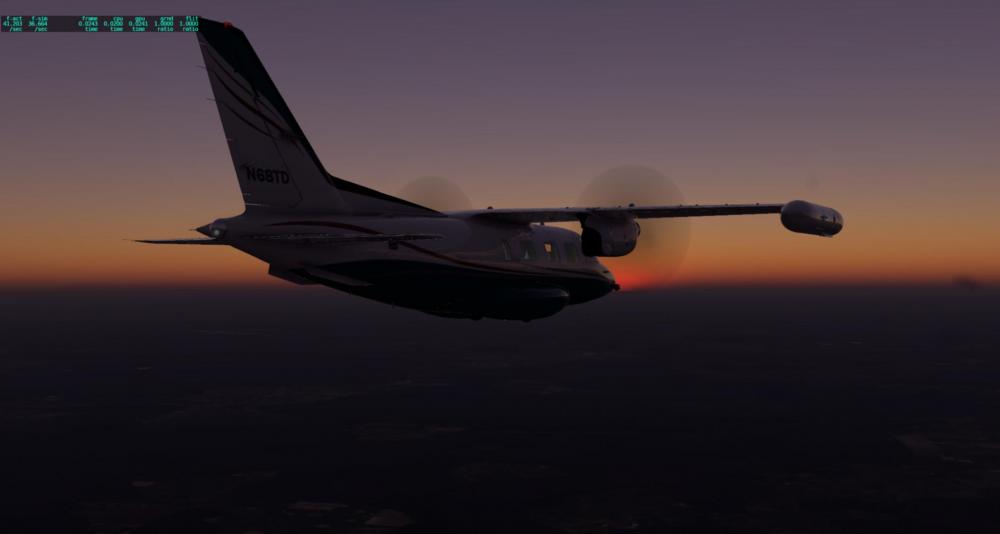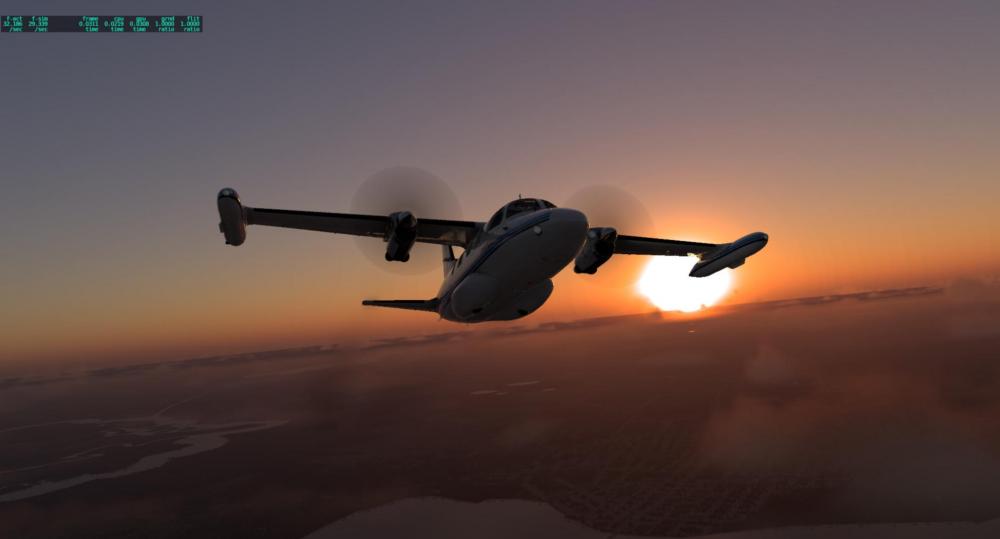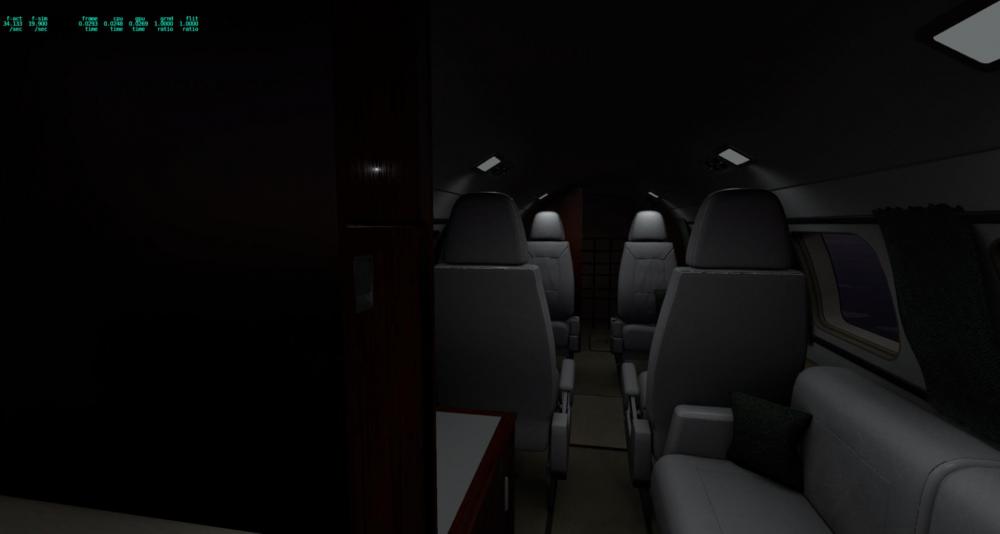Leaderboard
Popular Content
Showing content with the highest reputation on 10/08/2022 in all areas
-
1 point
-
View File Hot Start Challenger 650 - Sun-Air OY-LLG Based on real world CL650 OY-LLG operated by Sun-Air. I had to take some creative liberties with the cheatline as it did not fit 100% on the model as per the real airframe and I couldn't get the line to intersect the nose, cabin door, overwing exit and APU area closely to the real airframe without it - I hope the end result is ok! The registration CANNOT be changed due to limitation of this airframe having a wing registration so I opted not to use the built-in registration feature and painted the registration on the livery itself. NOTE: Painted for XP12's new lighting engine - NOT tested in XP11. Appearance may be unsatisfactory in XP11 Features: Custom airframe-specific placards Adjusted AO layers Custom cabin interior based on real airframe with custom carpet normal maps Not to be distributed or copied without explicit permission. Submitter MadProf Submitted 10/07/2022 Category Hot Start Challenger 650 Livery For https://www.x-aviation.com/catalog/product_info.php/take-command-hot-start-challenger-650-p-2121 point
-
Version 1.1.1
704 downloads
Inspired by real world GL7T M-NSTR operated by YYA Management Ltd. The registration CANNOT be changed due to the location on the vertical stabiliser so I opted not to use the built-in registration feature and painted the registration on the livery itself. NOTE: Painted for XP12's new lighting engine - NOT tested in XP11 but should work ok Features: Adjusted AO layers Adjusted exterior labels Not to be distributed or copied without explicit permission.1 point -
View File Hot Start Challenger 650 - Private Owner M-YJET Inspired by real world GL7T M-NSTR operated by YYA Management Ltd. The registration CANNOT be changed due to the location on the vertical stabiliser so I opted not to use the built-in registration feature and painted the registration on the livery itself. NOTE: Painted for XP12's new lighting engine - NOT tested in XP11 but should work ok Features: Adjusted AO layers Adjusted exterior labels Not to be distributed or copied without explicit permission. Submitter MadProf Submitted 09/27/2022 Category Hot Start Challenger 650 Livery For https://www.x-aviation.com/catalog/product_info.php/take-command-hot-start-challenger-650-p-2121 point
-
View File Hot Start Challenger 650 - VistaJet 9H-VFE Based on real world CL605 9H-VFE operated by VistaJet. I had to take some creative liberties with the cheatline as it did not fit 100% on the model as per the real airframe and I couldn't get the line to intersect the nose, cabin door, overwing exit and APU area closely to the real airframe without it - I hope the end result is ok! The registration CANNOT be changed due to limitation of this airframe having a wing registration so I opted not to use the built-in registration feature and painted the registration on the livery itself. NOTE: Painted for XP12's new lighting engine - NOT tested in XP11. Appearance may be unsatisfactory in XP11 Features: Beautiful custom PBR silver paint effect Adjusted AO layers Adjusted exterior labels Not to be distributed or copied without explicit permission. Submitter MadProf Submitted 09/27/2022 Category Hot Start Challenger 650 Livery For https://www.x-aviation.com/catalog/product_info.php/take-command-hot-start-challenger-650-p-2121 point
-
X-Plane 12 is in early access. It's a public beta. There will be many changes, some minor, some major. Laminar have had a private developers chat channel for months already. We've helped them work through a lot of bugs already. Opening the product to the public will find many more. When X-Plane 12 settles down and exits "early access" you're likely to see more products officially updated.1 point
-
Kirk, The visual approach functionality is one of the best things about this airplane and we use it all of the time. I'd have a hard time giving it up. If the ATIS is advertising visual approaches, we will select the visual approach in the FMS. Most of the time we will select 3nm for the RX. Assuming we are more or less 'straight in' when we're cleared for the visual approach, the PF will ask for 'direct to the RX'. The PM will make the selection in the FMS, verify with the PF that it is correct before execution, and when that is complete, the PF will typically ask the PM to 'spin [it] to zero' , meaning the PM sets the ALT selector to zero. The AP is typically on at this point, and the PF sets up the FCP by selecting APPR and VNAV. The PF will also check and verbalize that the computed TOD is 'in front' of the airplane to ensure the airplane isn't already above the computed path. If it is - then the PF will have to select a vertical mode to get the airplane heading downhill to an intercept of the PATH. (The timing of all this varies considerably depending which way we are approaching from, what altitude we are currently at, etc.) Quite often when an airport in the US advertises the visual approach - ATC may still reference an IAP waypoint as part of the initial approach; typically the GS intercept if the runway is served by an ILS. For this reason we always insert that waypoint before the 3nm RX - and we input the IAP crossing altitude. Quick example: KBDL is advertising visual approaches to runways 24 and 33 on the ATIS. Today we are going to Signature Flight Support and the winds are light and variable - so we brief that we will request runway 33 when checking in with BDL Approach. We setup the FMS with the visual RW33, with a 3nm final - ands insert HOMEY at 1800ft. (HOMEY is the GS intercept for the ILS 33). Upon being handed off from Boston Center to BDL Approach, we check-in with the ATIS and request 33. We're given direct HOMEY for the visual 33. This happens quite often, and is why we are prepared to reference the primary underlying approach even though the ATIS is advertising visuals. If we're somewhere we don't fly often - this can surprise you if you aren't prepared and don't know the IAP waypoint. From here at some point we'll be asked if we have the airport in sight or the preceding aircraft - and if we do - we're cleared for the visual 33. We setup per the above and from here it's just automation and energy management. The AP is on - our eyeballs are outside - we have automated lateral and vertical guidance to a stabilized visual approach. Better than an ILS in the sense that there's no NAV to NAV transfer and a go-around already has us selected to FMS source. Briefing for the missed when expecting the visual would take into account traffic pattern altitude and direction for that runway as well as some situational awareness on obstacles on the upwind and close-in to the airport. Thoughts on your scenario 1 outline vs IRL: - Select Visual Approach in FMS and possibly adjust the distance (defaults to 5 nm). [Most typically use 3nm IRL, more if required by circumstance]- arm NAV and APPR [pick one - but can't do both - we leverage APPR - schoolhouse suggests NAV for some bigger picture consistency (save that for later)]- ALT set down to the ground (I believe this is req'd w/ "Visual Approach" in FMC) [ALT set to zero or field elevation in order for airplane to descend at PATH intercept]- VNAV armed (is this req'd for the simulated GP to display in the "Visual Apch" mode?) [VNAV armed with ALT set to zero for airplane to descend on PATH]- AP and ATS deactivated [Up to you - depending on circumstance - Automation has benefits you progressively forfeit as levels of automation are reduced - but it's good to keep hands and skills sharpened. Be smart with your choice based on situation; don't try to be a hero handflying in a busy terminal area with lots of traffic, lots going on] Thoughts on your scenario 2 outline vs IRL: This would be what we'd describe as 'a visual backed up by the ILS' where the jet will nav to nav transfer from FMS to LOC. - Select the ILS approach in FMS (rather than Visual Apch) and use it as a reference, similar to Scenario 1 [Yes]- rest is the same except ALT does not have to be set down to the ground, and VNAV does not have to be activated [Correct - GS will capture similar to VGP regardless of ALT selector - and you can set your pattern altitude - or briefed go-around altitude upon GS capture] I much prefer scenario 1 as it is cleaner - but scenario 2 is handy when it's VFR yet the ATIS advertises an ILS or IAP - and therefore that is what you're setup and prepared/briefed for. At some point on the approach you may press the situation and announce the field in sight - and maybe you'll get the visual clearance -or perhaps ATC asks you and reply you have it in sight and get the visual clearance. Since you're already setup for the ILS - it becomes a visual backed up by the ILS - no more messing with the box close-in - and that's a good example of when you'd use Scenario 2. Considerations: If it's our first time to the airport, or we haven't been there in quite some time - or it's an airport with obstacles/terrain / 'sh*t to hit' or it's dark, we may just ask for the IAP despite the good weather. That pushes us more into 'scenario 2'. Home base - sea level airport - no terrain, minimal obstacles = Scenario 1. If approaching the airport from opposite side of airport - example: Visual 33 KBDL and we're coming from the NW and being vectored onto a left downwind to RW33 = Setup per scenario 1 except put the RX at 4nm, if on radar vectors and flying in HDG mode - perform a Direct To Intercept to the RX but enter a base course in Right LSK 6 spot on CDU. For inbound course of 330, this would be 060. Once cleared for the visual approach - selecting APPR (or NAV) + VNAV + preselect to zero = the airplane will fly a beautiful left base to final and because of the 4nm RX - you're ensuring a more stabilized rollout before 1000' above the airport. If approaching airport from straight in side of airport in HDG receiving radar vectors - perform a Direct TO Intercept to the RX and 'extend the line' through the RX by inputting the final approach course in Right LSK 6. For example with RW33 = 330. Then when cleared for the approach you select APPR (or NAV) + VNAV + preselect to zero = the airplane will intercept the extended centerline for the visual approach. ALT selector to zero vs field elevation will change the altitude alert dynamic. Some pilots prefer field elevation for this reason. If you're expecting and or subsequently cleared for a visual approach from scenario 1 or 2 - understand you were not cleared for the ILS or other IAP. Therefore in a go-around scenario - ATC is not expecting you to fly the IAP MAP. I've flown with a lot of professional pilots that will enter into scenario 2 and brief 'visual backed up by the ILS' and proceed to brief the IAP MAP. NAV vs APPR: The schoolhouse has suggested that to keep our heads straight between the different types of approaches and FCP selections - for the visual approach they have recommended NAV/VNAV1 point







